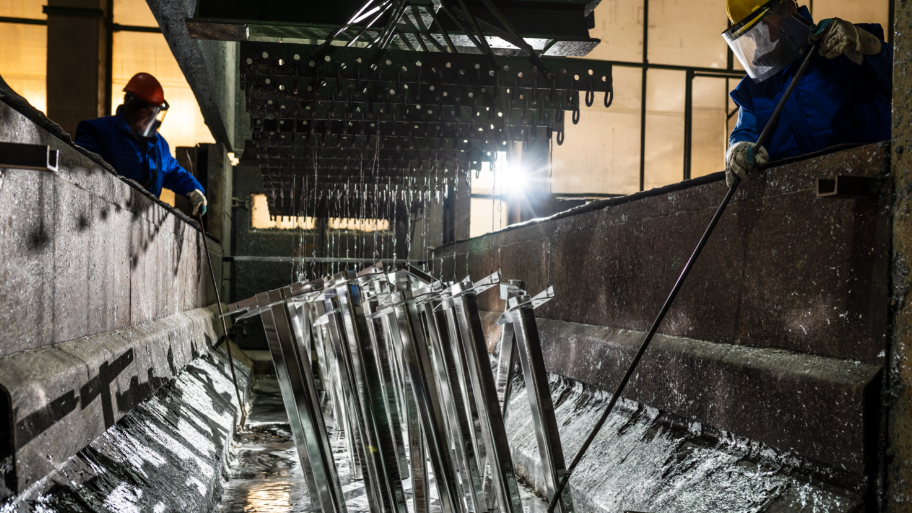
(The opinions expressed here are those of the author, Andy Home, a columnist for Reuters.)
Once bitten, twice shy.
When Nyrstar said in October it was reducing output by up to 50% at its European smelters in the face of spiralling energy prices, London Metal Exchange (LME) zinc rocketed to a 14-year high of $3,944 per tonne.
The rally proved short lived, zinc giving back just about all of its gains in the space of two weeks. It was last trading around $3,260 per tonne.
The market has had a collective rethink about what “up to 50%” might mean and has decided that Nyrstar is probably modulating production around peak power times with a smaller than implied hit to actual output.
So when Glencore announced last month it intended to place its Italian zinc smelter on care and maintenance by the end of December, the zinc price managed only a small blip higher.
But this closure is now shaking up the European zinc supply chain with premiums rocketing as users scramble for available material.
Moreover, with European power prices likely to remain high over the coming winter months, the threat of more significant supply-side losses is starting to be priced into the bigger zinc picture.
European physical zinc premiums have shot higher since Glencore said its 100,000-tonne per year Portovesme zinc sulphide plant would stop producing zinc by the end of December.
/cloudfront-us-east-2.images.arcpublishing.com/reuters/FQSQ2M6ZABKZZKQBB4PIRPWOWA.png)
Fastmarkets assesses the premium for LME-grade SHG zinc in Italy at $400-450 per tonne over the LME cash price. The premium has doubled since the start of October.
The Fastmarkets premium for zinc in Antwerp has nearly tripled from $95-105 at the start of the year to a current $250-280.
[Click here for an interactive chart of zinc prices]
Producers and consumers are currently negotiating terms for next year’s deliveries with contracted pricing rising sharply in tandem with the spot market.
European zinc users are particularly exposed to any loss of supply because of low inventory.
The LME’s European warehouses hold a meagre 3,225 tonnes, split between the Spanish port of Bilbao (3,200 tonnes) and the Dutch port of Vlissingen (25 tonnes) and just about all of it cancelled in preparation for load-out.
Currently available European stocks total just 50 tonnes at Bilbao and the LME’s most recent off-warrant stocks report showed nothing more hiding in the shadows at the end of September.
LME stocks, both on- and off-warrant, are largely located at Asian locations, which has left thin cover for European consumers.
Compounding the sense of panic is the lack of visibility on how much zinc production might be lost to a power crunch that shows no signs of abating.
Glencore has already said it is adjusting production at its other smelters to lower usage during peak periods and Nyrstar is in all likelihood doing something similar.
That is constraining refined zinc production, albeit maybe not as much as implied by Nyrstar’s original statement.
The question, as European power prices continue rising, is how long such mitigation tactics can work.
Europe’s zinc and aluminum smelters have the highest exposure to power costs measured by the ratio of raw material margin, according to analysts at Citi. (“Annual Commodities Outlook – 2022”)
While Europe’s aluminum smelters account for just 3% of global supply, its zinc smelters make up around 16% of world refined zinc production.
That means Europe’s power problems have significance beyond the regional supply-chain.
The curtailment of Portovesme and some level of production loss at other European smelters has pushed JPMorgan’s global market balance calculations into a small deficit both this year and next.
The bank now expects the zinc price to “embed a significant risk premium for European disruptions through the winter” with a forecast average of $3,400 per tonne in the first quarter of 2022. (“Base and Precious Metals Outlook 2022”, Nov. 29, 2021)
Citi, which is also expecting a global supply shortfall, excluding any potential Chinese state reserve sales, has a short-term price target of $3,350 per tonne “with considerably higher upside if more European smelters (or others) make cuts.”
These bull calls reflect a collective reassessment of the market’s dynamics after the International Lead and Zinc Study Group drastically revised its expectations of significant supply surplus in October.
Indeed, the Group’s latest monthly update indicates a global market supply deficit of 93,000 tonnes in the first nine months of the year.
Falling LME stocks reinforce the message. Headline inventory has almost halved since April and at 150,675 tonnes are the lowest they’ve been since July last year. Cancelled tonnage awaiting load-out accounts for a fifth of the total.
LME time-spreads remain acutely tight.
The cash premium over three-month metal whipped out to $130 in late November and was still an elevated $61.75 at Tuesday’s close.
The zinc market is turning out to be considerably tighter than anyone expected just a few months ago.
The outright price may have largely shrugged off the Portovesme news, but stressed time-spreads and surging physical premiums say zinc could get tighter yet if Europe’s power crunch becomes more severe.
(Editing by Kirsten Donovan)
Comments